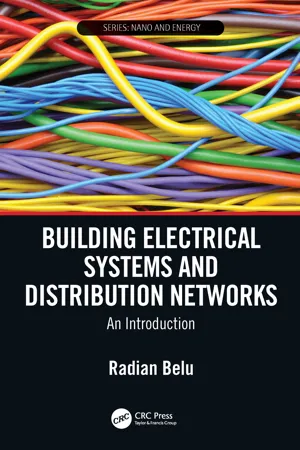
- 590 pages
- English
- ePUB (mobile friendly)
- Available on iOS & Android
About This Book
This book covers all important, new, and conventional aspects of building electrical systems, power distribution, lighting, transformers and rotating electric machines, wiring, and building installations. Solved examples, end-of-chapter questions and problems, case studies, and design considerations are included in each chapter, highlighting the concepts, and diverse and critical features of building and industrial electrical systems, such as electric or thermal load calculations; wiring and wiring devices; conduits and raceways; lighting analysis, calculation, selection, and design; lighting equipment and luminaires; power quality; building monitoring; noise control; building energy envelope; air-conditioning and ventilation; and safety. Two chapters are dedicated to distributed energy generation, building integrated renewable energy systems, microgrids, DC nanogrids, power electronics, energy management, and energy audit methods, topics which are not often included in building energy textbooks. Support materials are included for interested instructors. Readers are encouraged to write their own solutions while solving the problems, and then refer to the solved examples for more complete understanding of the solutions, concepts, and theory.
Frequently asked questions
Information
Table of contents
- Cover
- Half Title
- Series Page
- Title Page
- Copyright Page
- Dedication
- Contents
- Preface
- About the Author
- Chapter 1 Review, Power Systems, Energy, and Economics
- Chapter 2 Review of Electric Circuits and Power System Basics
- Chapter 3 Building Power Supply and Industrial Power Distribution
- Chapter 4 Electrical System Design, Load Calculation, and Wiring
- Chapter 5 Circuit Protection, Grounding, and Service
- Chapter 6 Lighting Fundamentals, Lighting Equipment, and Systems
- Chapter 7 Transformers and Electrical Motors
- Chapter 8 Building Energy Systems, Heat, and Air-Conditioning
- Chapter 9 Distributed Generation and Energy Storage
- Chapter 10 Building-Integrated Renewable Energy and Microgrids
- Chapter 11 Building Automation, Control, Communication, and Monitoring
- Chapter 12 Energy Management, Energy Conservation, and Efficiency
- Appendix A: Common Parameters, Units, and Conversion Factors
- Appendix B: Design Parameters, Values, and Data
- Index